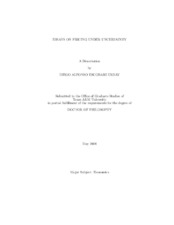| dc.contributor.advisor | Gan, Li | |
| dc.creator | Escobari Urday, Diego Alfonso | |
| dc.date.accessioned | 2008-10-10T20:55:55Z | |
| dc.date.available | 2008-10-10T20:55:55Z | |
| dc.date.created | 2008-05 | |
| dc.date.issued | 2008-10-10 | |
| dc.identifier.uri | https://hdl.handle.net/1969.1/85918 | |
| dc.description.abstract | This dissertation analyzes pricing under uncertainty focusing on the U.S. airline
industry. It sets to test theories of price dispersion driven by uncertainty in the demand
by taking advantage of very detailed information about the dynamics of airline
prices and inventory levels as the flight date approaches. Such detailed information
about inventories at a ticket level to analyze airline pricing has been used previously
by the author to show the importance of capacity constraints in airline pricing.
This dissertation proposes and implements many new ideas to analyze airline pricing.
Among the most important are: (1) It uses information about inventories at a
ticket level. (2) It is the first to note that fare changes can be explained by adding
dummy variables representing ticket characteristics. Therefore, the load factor at a
ticket level will lose its explanatory power on fares if all ticket characteristics are
included in a pricing equation. (3) It is the first to propose and implement a measure
of Expected Load Factor as a tool to identify which flights are peak and which ones
are not. (4) It introduces a novel idea of comparing actual sales with average sales
at various points prior departure. Using these deviations of actual sales from sales
under average conditions, it presents is the first study to show empirical evidence of
peak load pricing in airlines. (5) It controls for potential endogeneity of sales using
dynamic panels.
The first essay tests the empirical importance of theories that explain price dispersion
under costly capacity and demand uncertainty. The essay calculates a measure of an Expected Load Factor, that is used to calibrate the distribution of demand
uncertainty and to identify which flights are peak and which ones are off-peak. It
shows that different prices can be explained by the different selling probabilities. The
second essay is the first study to provide formal evidence of stochastic peak-load pricing
in airlines. It shows that airlines learn about the demand and respond to early
sales setting higher prices when expected demand is high and more likely to exceed
capacity. | en |
| dc.format.medium | electronic | en |
| dc.language.iso | en_US | |
| dc.publisher | Texas A&M University | |
| dc.subject | peak load pricing | en |
| dc.subject | airlines | en |
| dc.subject | price discrimination | en |
| dc.subject | demand uncertainty | en |
| dc.subject | costly capacity | en |
| dc.subject | demand learning | en |
| dc.title | Essays on pricing under uncertainty | en |
| dc.type | Book | en |
| dc.type | Thesis | en |
| thesis.degree.department | Economics | en |
| thesis.degree.discipline | Economics | en |
| thesis.degree.grantor | Texas A&M University | en |
| thesis.degree.name | Doctor of Philosophy | en |
| thesis.degree.level | Doctoral | en |
| dc.contributor.committeeMember | Hwang, Hae-Shin | |
| dc.contributor.committeeMember | Puller, Steven | |
| dc.contributor.committeeMember | Wu, Ximing | |
| dc.type.genre | Electronic Dissertation | en |
| dc.type.material | text | en |
| dc.format.digitalOrigin | born digital | en |


